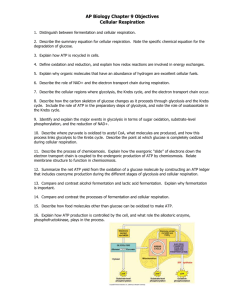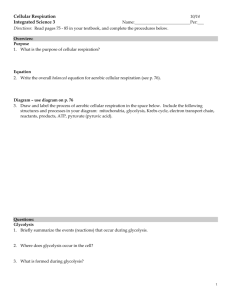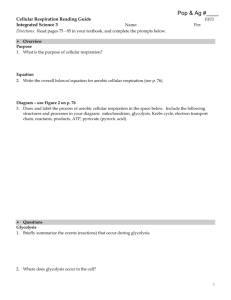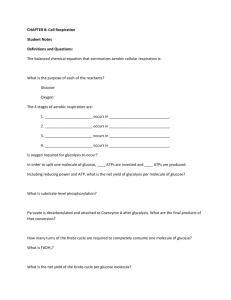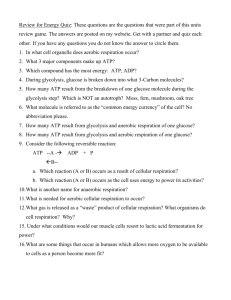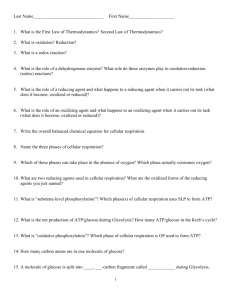Study Guide to Cellular Respiration
advertisement
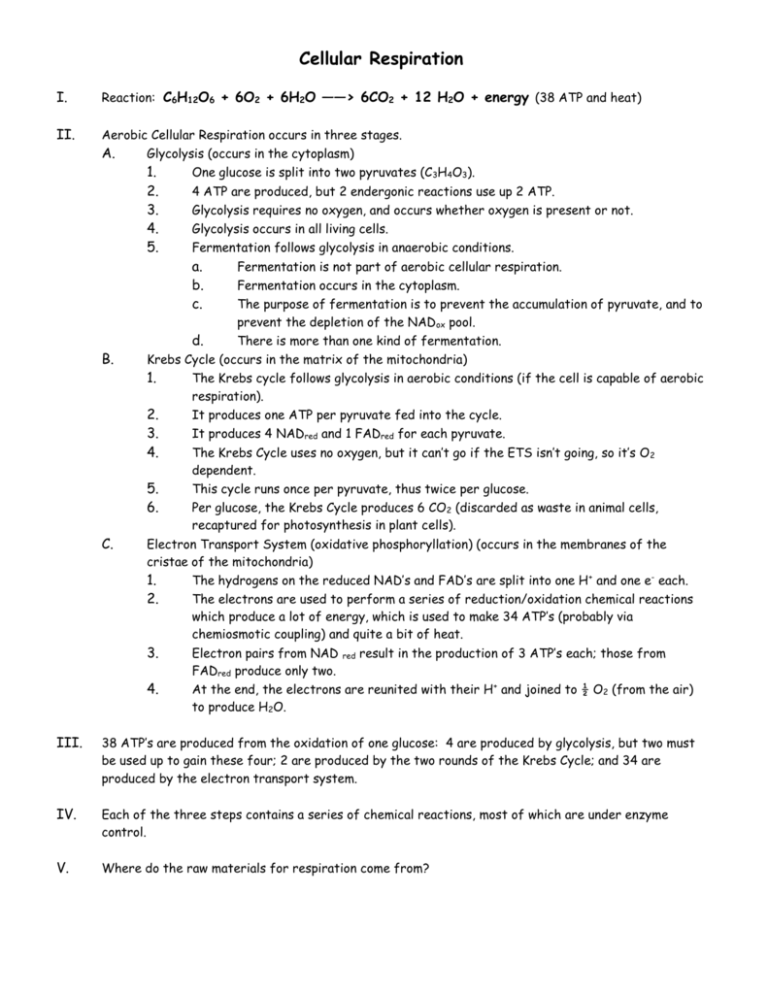
Cellular Respiration I. Reaction: C6H12O6 + 6O2 + 6H2O ——> 6CO2 + 12 H2O + energy (38 ATP and heat) II. Aerobic Cellular Respiration occurs in three stages. A. B. Glycolysis (occurs in the cytoplasm) 1. 2. 3. 4. 5. 4 ATP are produced, but 2 endergonic reactions use up 2 ATP. Glycolysis requires no oxygen, and occurs whether oxygen is present or not. Glycolysis occurs in all living cells. Fermentation follows glycolysis in anaerobic conditions. a. b. c. Fermentation is not part of aerobic cellular respiration. d. There is more than one kind of fermentation. Fermentation occurs in the cytoplasm. The purpose of fermentation is to prevent the accumulation of pyruvate, and to prevent the depletion of the NADox pool. Krebs Cycle (occurs in the matrix of the mitochondria) 1. 2. 3. 4. 5. 6. C. One glucose is split into two pyruvates (C3H4O3). The Krebs cycle follows glycolysis in aerobic conditions (if the cell is capable of aerobic respiration). It produces one ATP per pyruvate fed into the cycle. It produces 4 NADred and 1 FADred for each pyruvate. The Krebs Cycle uses no oxygen, but it can’t go if the ETS isn’t going, so it’s O 2 dependent. This cycle runs once per pyruvate, thus twice per glucose. Per glucose, the Krebs Cycle produces 6 CO2 (discarded as waste in animal cells, recaptured for photosynthesis in plant cells). Electron Transport System (oxidative phosphoryllation) (occurs in the membranes of the cristae of the mitochondria) 1. 2. The hydrogens on the reduced NAD’s and FAD’s are split into one H + and one e- each. 3. Electron pairs from NAD FADred produce only two. 4. The electrons are used to perform a series of reduction/oxidation chemical reactions which produce a lot of energy, which is used to make 34 ATP’s (probably via chemiosmotic coupling) and quite a bit of heat. red result in the production of 3 ATP’s each; those from At the end, the electrons are reunited with their H + and joined to ½ O2 (from the air) to produce H2O. III. 38 ATP’s are produced from the oxidation of one glucose: 4 are produced by glycolysis, but two must be used up to gain these four; 2 are produced by the two rounds of the Krebs Cycle; and 34 are produced by the electron transport system. IV. Each of the three steps contains a series of chemical reactions, most of which are under enzyme control. V. Where do the raw materials for respiration come from? A. B. C. VI. Glucose comes from the food you eat. If you are a plant, you make your own glucose, which you probably store as starch. Oxygen comes from the air you breathe. If you are a plant, you produce oxygen as a waste product of photosynthesis. Water is the most plentiful substance in your body. What happens to the products of cellular respiration? A. B. C. D. E. ATP is used by your cells as the energy source for any endergonic chemical reactions which need to occur. Heat is a waste product. If you are endothermic, it is used to heat your body. Water is added back to your cell’s supply (pool). CO2 is a waste product of cellular respiration. If you are an animal, you discard it as a gas. If you are a plant, you recapture it and use it in photosynthesis (if the lights are on). HOWEVER, photosynthesis and respiration are separate processes, which occur in completely separate organelles, and plants do cellular respiration exactly the same way animals do it.



